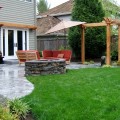Landscaping Pond
The ideal location for a landscaping pond is in a part of the yard that gets continuous sunlight. A pond that is completely shaded will have trouble supporting plants that need light to survive. A pond too close to trees may soon become covered in leaves and suffer from stagnation from rotting organic material. Open areas are therefore much more practical both from the standpoint of aquatic vegetation and practical water management.
On an aesthetic level, it works best to have a landscaping pond built in a part of the yard that appears central from different vantage point. For instance, if a person is standing on the threshold of an outdoor kitchen in the back of the yard and is looking back toward the house, the pond should appear proportionally distant from other landscape elements such as the swimming pool, custom patios, gardens, courtyards, and trees.
This does not mean that the landscaping pond must physically be located precisely between all these points, but rather that it be built in such a way that it APPEARS to be more or less equidistant from other elements when viewed from any major point of interest on the landscape.
The pond should never appear to be crowded against another landscape element in such a way as to appear blurred or diminished by another form.
This high demand for what amounts to an aesthetically pleasing optical illusion necessitates the skills of a professional landscape designer. A landscaping pond must be carefully designed as a significant element of a landscape master plan. In spite of its uniqueness, the pond must be created with relationship to other elements in mind in order to preserve the integrity of the landscape as a whole.
The most significant relationship your pond must have is to the home itself. This is because the intention of professional landscaping is to create an outdoor living environment that reflects the taste, interests, and personal lifestyle of the owner. In order for any residential landscape design to work, it has to compliment the home in a perceivable manner. A sense of reflection and congruence between the indoor and outdoor world must be apparent to the observer.
The addition of a landscaping pond can be a valuable addition to your backyard landscape when its construction is overseen by skilled professionals who will ensure that it is built in scale and proportion to the home and surrounding elements of Houston outdoor living.
It is also advisable to have the landscaping company install lights in the pond. Without light, the pond will only be clearly visible during the daytime and appear as a smudge of shadow with bits of reflected lighting showing in portions of its dark periphery. This will contribute nothing to outdoor charm and ambience and can actually work against your home entertainment venue. However, with low-voltage underwater lights (many of which are now available in super efficient LED form), both general lighting for visibility and special lighting effects are possible. LED fixtures in particular are very inexpensive to operate and pose no threat to human life, pets, or fish.
If you plan to stock your landscaping pond with fish, it is essential that you have oxygenating plants installed as well. Avoid the temptation to practice any aquatic gardening independently of your landscape company. Many plants, such as amaryllis, bottlebrush, boxwood, caladium, dapne, hydrangea, and bird of paradise, are toxic to fish species and must be avoided to maintain a healthy stock. Other plants provide much needed structure and shade for fish and are readily obtainable through your Houston landscape design professional.
As far as fish themselves go, the species you stock depends on the depth of the water and the available food and shelter that species needs. Koi are a popular species, but they require ponds of certain depth and structure. Goldfish are more rugged and can survive in a diversity of pond types and sizes. Larger ponds on larger properties can even support sun perch, catfish, or bass provided there is sufficient structure and depth to give them proper oxygen content and water temperatures

